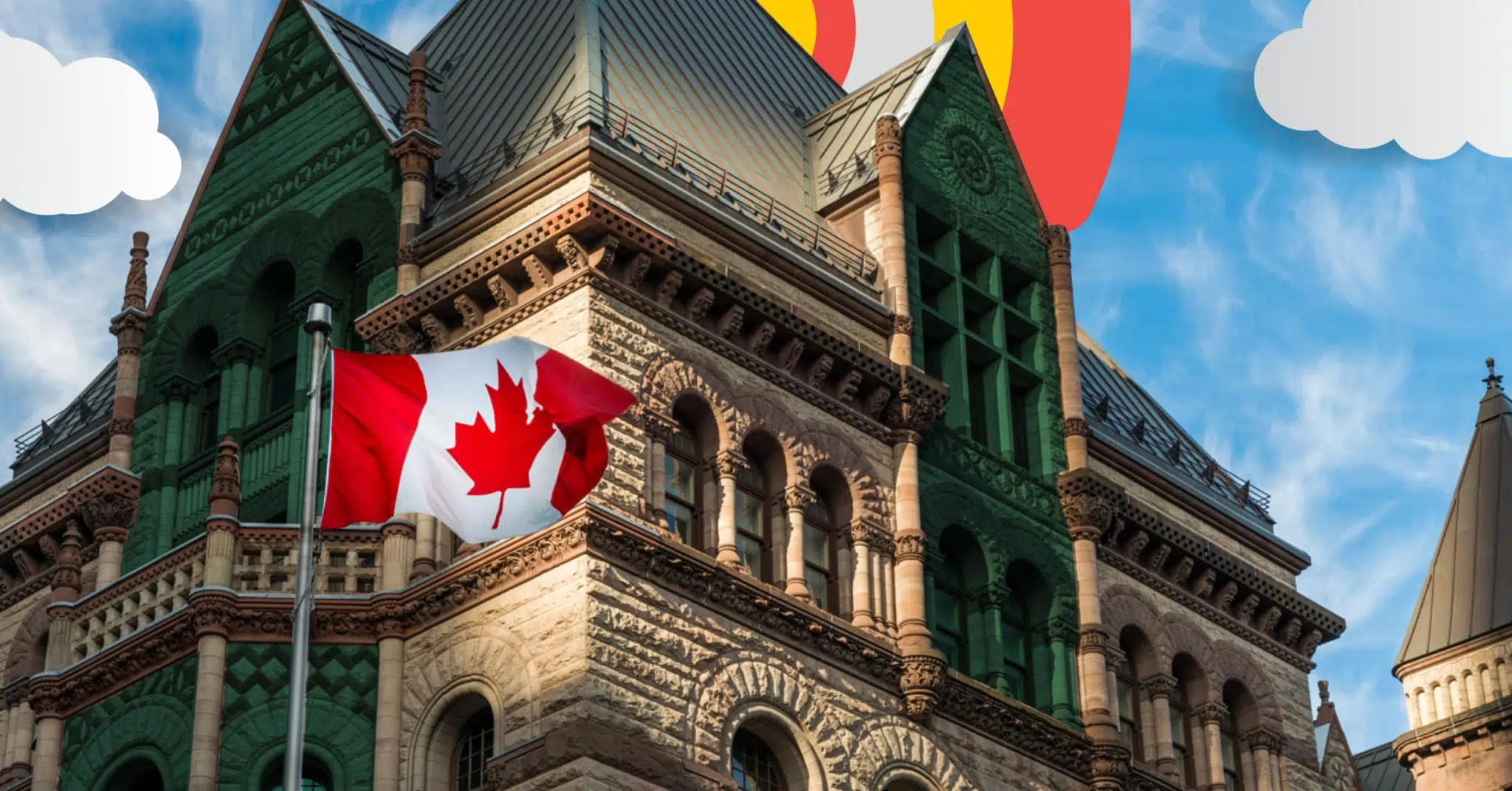How Are Mortgage Rates Determined in Canada?

Table of contents
In Canada, depending on the type of mortgage (fixed or variable), interest rates are primarily determined by the Bank of Canada (BoC) policy rate. This rate is the benchmark that banks, lenders, and other financial institutions use to set interest rates for loans, mortgages, and all other lending products. Benchmarks are the reference interest rates that determine the amount of other interest rates.
When it comes to mortgage rates, fixed and variable rates are priced higher than the BoC policy rate or bond yields because, as businesses, lenders need to make a profit from the money they lend to you. There are also borrowing costs and additional risks that make lending money for mortgages more risky and expensive, so they price these costs and add risks into the higher interest rate offered to you as the borrower.
Understanding the core of what determines interest rates will help you compare scenarios better when comparing rates offered to you. Whether you’re a first-time homebuyer or renewing or refinancing your mortgage, any change in interest rates can significantly affect the amount you pay toward interest-carrying costs on your mortgage.
Key Highlights
- The BoC policy rate determines variable-rate mortgages, while bond yields determine fixed-rate mortgages.
- Both fixed and variable mortgage rates are priced higher than the policy rate or bond yields to offset added mortgage risks and lending costs.
- The Bank of Canada adjusts its policy rate on 8 fixed dates each year, directly affecting variable lending products and indirectly affecting fixed lending products.
We’re curious…
How Are Mortgage Rates Determined in Canada?
Mortgage rates set by banks and lenders are determined in several ways, including the Bank of Canada’s (BoC) policy rate and bond yields. Personal influences, such as your credit score, loan-to-value ratio (LTV), down payment, and more, will also play a role in determining the interest rate offered to you.
Variable-rate mortgages are directly tied to the BoC policy rate. When this rate changes, either increasing or decreasing, financial institutions adjust their prime rate in line with the BoC change. Most financial institutions generally keep their prime rate at a difference of + 2.2% from the policy rate.
Fixed-rate mortgages are determined by the corresponding maturity bond yields, which are indirectly influenced by expectations of what the BoC will do with the policy rate in the future. They are typically priced 1% to 2% higher than bond yields.
Who Sets Mortgage Rates in Canada?
Lenders set mortgage rates in Canada and base their rates on the corresponding influencer.
Lenders set fixed mortgage rates following the trend of bond yields with similar term lengths. Since mortgages involve more risk and costs for the lender, these rates are set higher than the yields to help offset this risk.
Lenders set variable mortgage rates using their prime rate, influenced by the BoC policy rate. The prime rate is higher than the BoC policy rate, and the added costs and risks associated with mortgages are priced to help offset these for the lender.
Lenders will also set the interest rate for your mortgage by considering personal factors like the length of your mortgage term, amortization period, the current prime and posted rates when your application is submitted, the type of mortgage, and subject property use. Your credit score, income, LTV ratios, personal banking relationship with the lender, and other factors could qualify you for more of a discount than their posted rates.
The Bank of Canada and Its Hand in Mortgage Rates
The Bank of Canada influences mortgage rates through its monetary policy. Its objective is to keep inflation in check at 2% to preserve the value of the Canadian dollar. It does this by setting the target overnight rate, known as the policy rate. This rate is expected to be used as the benchmark that influences the rates that banks, lenders, and financial institutions set for their variable lending products.
What Affects Mortgage Rates?
The state of the economy largely affects mortgage rates. Inflation is the key determinant of economic stability and is an important economic indicator that impacts interest rates.
The relationship between inflation and interest rates often runs in parallel. When inflation is high, interest rates increase in an effort to tame inflation. When inflation is low, interest rates decrease in an effort to stimulate the economy.
What Determines Variable Mortgage Rates?
Variable-rate mortgages are determined by the BoC policy rate, which influences prime rates. When the policy rate changes, prime rates will change accordingly. Most lenders determine the prime rate based on the policy rate + 2.2%. The prime rate is the rate lenders will use to set their posted rates, which are the rates lenders advertise.
Posted rates combine the prime rate plus (+) or minus (-) additional percentage points. For example, you may see a variable interest rate advertised as prime + 0.5%, meaning you will be charged whatever the current prime rate is plus an additional 0.5%, or prime—0.5%, meaning you will be charged whatever the current prime rate is minus a 0.5% discount.
What Determines Fixed Mortgage Rates?
Fixed-rate mortgages are determined by bond yields with comparable terms (5-year fixed rates will follow trends in 5-year bond yields). Fixed-rate mortgages historically have been priced 1% – 2% higher than bond yields. If the current 5-year bond yield is 4%, you can expect that 5-year fixed mortgage rates would be in the 5% to 6% range.
Government bonds are typically traded in anticipation of BoC rate announcements. To explain this:
If inflation is high and bad news is anticipated, bond prices will likely fall, and bond yields will rise as traders expect a rate hike announcement. If this occurs, interest rates can rise since they are influenced by bond yields rather than prices.
If inflation is low and good news is anticipated, bond prices will likely increase, and their yields will fall as traders expect rates to decrease. If this occurs, you can expect interest rates to decrease since they are influenced by bond yields and not prices.
Bond prices behave inversely to their yields. As yields rise on newly issued bonds, prices on existing bonds fall in an effort to make them more attractive to potential buyers. As yields fall on newly issued bonds, prices on existing bonds will rise, so sellers are compensated for foregoing higher yields on their bonds.
How Do Interest Rates Impact Home Affordability?
Interest rates impact home affordability inversely, though other factors can play a mitigating role. Regardless of the trajectory of interest rates in a given economy, the supply and demand of housing play a greater influence on home prices.
If interest rates increase, this decreases affordability for homebuyers who require a mortgage to finance their purchase. As interest rates increase, so do borrowing costs, leading to higher mortgage payments. Higher interest rates erode purchasing power. In turn, the demand for homes may also decrease as fewer buyers can qualify to afford the same mortgage that they could before rates increased.
For each $100,000 mortgage balance over a 25-year amortization, an approximate $15 increase to your monthly mortgage payment is realized each time interest rates increase by 25bps (equal to 0.25%).
To illustrate this:
- If you have a $500,000 mortgage with a 25-year amortization and a fixed mortgage interest rate of 5.14%, you will pay approximately $2,964 in monthly mortgage payments.
- If interest rates increased by 1% to 6.14%, your monthly mortgage payment would increase to approximately $3,266. This means you would pay an additional $302 per month.
If interest rates decrease, this increases affordability, especially for homebuyers who require mortgages to finance their purchase. As interest rates decrease, so does the cost of borrowing money, leading to lower mortgage payments. Lower interest rates allow your dollar to stretch further. In turn, demand for homes may increase as more buyers enter the market and more easily qualify for a mortgage.
Consequently, as debt-service loans become less expensive, lenders’ inherent risks reduce along with interest rates, increasing liquidity (the availability of money) in the economy.
The Impact of Lower Interest Rates on the Economy
When inflation is too low, the BoC decreases the policy rate, encouraging banks, lenders, and financial institutions to follow suit and lower interest rates. Lower interest rates stimulate the economy by encouraging borrowing and spending.
More borrowing and spending in the economy means a higher demand for goods and services. This drives up the cost of purchasing these items as higher demand makes it harder to maintain a consistent supply. This may cause inflationary pressures and eventually increase inflation, consequently reigniting the economic cycle that Canada has historically experienced every 5 to 7 years.
The Impact of Higher Interest Rates on the Economy
When inflation is too high, the BoC increases the policy rate to encourage banks, lenders, and financial institutions to increase interest rates. Higher interest rates discourage borrowing and spending in an effort to cool the market and tame inflation. They also reduce disposable income and limit growth.
Less borrowing and spending in the economy means that demand for goods and services declines. Lower demand allows supply to catch up and prices to increase more gradually or decrease (go on sale) in an effort to encourage demand. This tends to ease inflationary pressures and lowers inflation.
Higher interest rates can sometimes lead to a recession if rates are increased too rapidly without giving the economy enough time to catch up.
Always Know the Bank of Canada’s Rate Schedule to Track Mortgage Rate Updates
The BoC adjusts its policy rate on 8 fixed dates each year. When the policy rate is adjusted, banks, lenders and financial institutions adjust their prime rates accordingly, affecting variable lending products.
Below is the policy rate schedule for the BoC announcements in 2024.
| BoC 2024 Policy Rate Schedule |
|---|
| January 24 |
| March 6 |
| April 10 |
| June 5 |
| July 24 |
| September 4 |
| October 23 |
| December 11 |
How Do Mortgage Stress Test Rates Get Set?
The Office of the Superintendent of Financial Institutions (OSFI) sets mortgage stress test rates to assess whether you can continue to make mortgage payments if faced with financial challenges. The stress test rule sets a minimum qualifying rate (MQR), which is currently 5.25% (the “floor”), or your contract rate plus 2% (the “buffer”), whichever is higher.
The floor of 5.25% is the rate set to account for risks to the borrower from economic fluctuations. This rate is set through OSFI’s analysis of the various financial vulnerabilities of borrowers and federally regulated financial institutions that could lead to mortgage defaults or threaten the financial system.
The buffer set by OSFI at + 2% of your contract rate builds in a margin of safety to test whether borrowers can withstand changes to their financial circumstances, such as increasing mortgage rates or changes in income.
Frequently Asked Questions
How are mortgage rates determined in Canada?
Mortgage interest rates are primarily determined by the Bank of Canada (BoC) policy rate. Fixed-rate mortgages follow trends in bond yields with similar term lengths. Bond yields are indirectly influenced by what the market expects will happen with the BoC policy rate. Variable-rate mortgages are adjusted based on the lender’s prime rate, which is set against the BoC policy rate plus a spread, usually 2.2%.
What is the difference between fixed-rate and variable-rate mortgages?
A fixed-rate mortgage has a fixed interest rate over the entire mortgage term. This means your total payment and the interest and principal components remain the same throughout your term. Fixed-rate mortgages are determined by comparable bond yields, meaning a 5-year fixed-rate mortgage will follow the trend of 5-year bond yields.
A variable-rate mortgage has an interest rate that can fluctuate over the mortgage term. This means that depending on the type of variable mortgage you have, your interest portion will adjust according to changes in interest rates. Variable rate mortgages are determined by the BoC policy rate, meaning that prime rates will follow when the policy rate changes.
What factors affect mortgage rates in Canada?
The economy, particularly inflation, is one of Canada’s most significant factors affecting mortgage rates. This is due to monetary policy, where the BoC adjusts its policy rates, either increasing or decreasing, to control inflation and bring it to the 2% target.
When the policy rate is adjusted, banks will adjust their prime rate on variable mortgage products in line with changes to the policy rate. Since bond yields are indirectly influenced by what the BoC is expected to do with its policy rate, these changes will also indirectly affect fixed-rate mortgages.
How often do mortgage rates change?
Fixed mortgage rates correlate their fluctuations with the corresponding bonds’ yields, which change daily. Discounts on new variable mortgage rates can change as often as a lender’s cost of business and risk change. However, based on BoC policy rate decisions directly correlated to lenders’ prime rates, existing variable-rate mortgages can be impacted up to eight times yearly.
Final Thoughts
The Bank of Canada’s policy rate and bond yields affect the cost of mortgages. Whenever the BoC moves to adjust its policy rate, it affects variable-rate mortgages, which react quickly to changes in the policy rate.
On the other hand, rates for fixed-rate mortgages change based on bond yields and are slower to adjust. Depending on market conditions, mortgage rates may increase or decrease at any time, so it’s advisable for borrowers to monitor the economy closely.
While no one can accurately predict what the future holds or where mortgage rates are headed, having the knowledge of how these rates are influenced is key to making smart, well-informed financial decisions. Reach out to nesto’s mortgage experts to see how we can help you secure funding on your new home or lower your rate on your renewal.
Why Choose nesto
At nesto, our commission-free mortgage experts, certified in multiple provinces, provide exceptional advice and service that exceeds industry standards. Our mortgage experts are non-commissioned, salaried employees who provide impartial guidance on mortgage options tailored to your needs and are evaluated based on client satisfaction and advice quality. nesto aims to transform the mortgage industry by providing honest advice and competitive rates using a 100% fully digital, transparent, seamless process.
nesto is on a mission to offer a positive, empowering and transparent property financing experience – simplified from start to finish.
Contact our licensed and knowledgeable mortgage experts to find your best mortgage rate in Canada.
Find a better rate, and we’ll match it, beat it, or give you $500*.
*Conditions Apply
With nesto, it’s stress-free
Ready to get started?
In just a few clicks, you can see our current rates. Then apply for your mortgage online in minutes!















